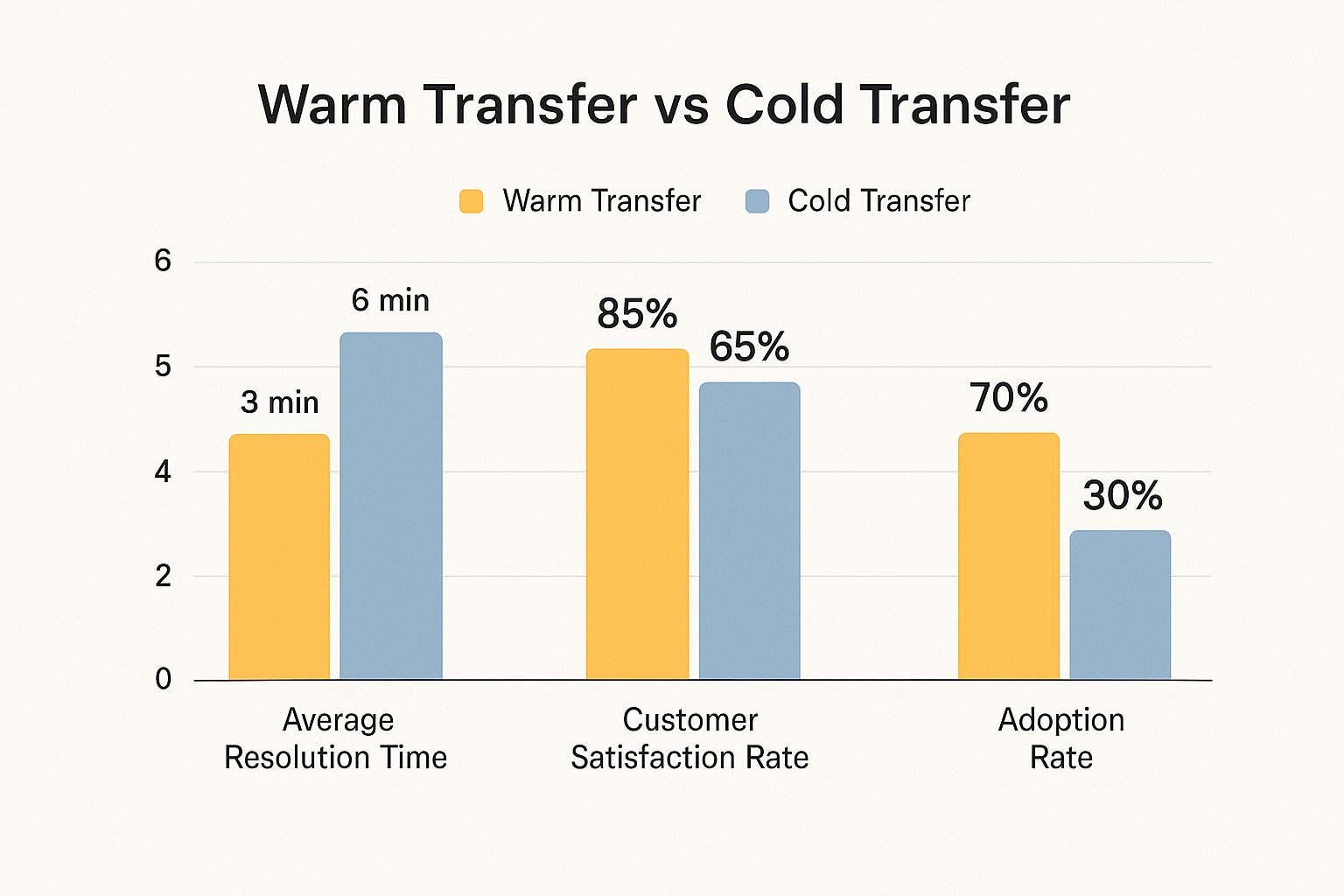Understanding What Really Matters In Transfer Methods

In the busy world of Australian call centers, how you manage call transfers significantly impacts the customer experience. It's not just about connecting callers; it's about creating a seamless and positive experience. This starts with understanding the difference between warm transfers and cold transfers.
Warm Transfers: The Personal Touch
A warm transfer involves a quick chat between the initial agent and the transfer recipient before connecting the caller. This allows the first agent to give context, ensuring the next agent is prepared. This prevents customers from repeating their story, saving time and frustration.
For example, if a Telstra customer calls about a technical problem, the initial agent can brief the tech specialist beforehand. This allows for a faster resolution. This personalized touch has proven effective in Australia, boosting customer satisfaction and loyalty. Discover more about warm transfers here.
Cold Transfers: A Quick Handoff
A cold transfer connects the caller directly to another agent without any prior conversation. This method is fast and efficient, quickly routing the caller. However, the receiving agent starts with no knowledge of the situation, potentially leading to a less personal experience.
This approach works for simple questions or routing to the correct department. But consider the potential trade-off in customer satisfaction.
Choosing the Right Transfer Method
So, when should you use each method? Warm transfers are best for complex issues, emotional callers, or when detailed account information is needed. They show a commitment to personalized service, crucial for customer retention in Australia.
Cold transfers are better for routine inquiries, wrong numbers, or after-hours support where quick redirection is key. The best approach depends on the situation and your company's priorities.
Understanding these differences lets you tailor your strategy to meet customer needs and business goals. This improves customer satisfaction, streamlines operations, and builds a positive brand image in the competitive Australian market.
The Numbers That Actually Drive Business Decisions

The infographic above provides a clear comparison of warm and cold transfers. It focuses on three key metrics: average resolution time, customer satisfaction, and adoption rate. The data clearly indicates that warm transfers outperform cold transfers, particularly in resolution time and customer satisfaction, ultimately leading to higher adoption rates. This makes a compelling case for Australian businesses looking to enhance their customer experience and improve operational efficiency.
What are the most critical performance indicators (KPIs) for your business? While call volume provides a basic overview, truly successful Australian businesses prioritize first-call resolution rates and customer satisfaction scores.
These KPIs offer valuable insights into the effectiveness of your transfer methods. For example, data suggests warm transfers often lead to significantly higher first-call resolution rates. This improvement has a ripple effect, boosting both efficiency and customer satisfaction. You can find more detailed statistics on warm transfers versus cold transfers at HiRate Solutions.
Measuring Success Beyond Call Volume
Focusing on the right metrics isn't about superficial numbers. It's about choosing KPIs that directly impact business growth and customer loyalty within the Australian market. Consider the impact of implementing a warm transfer system. Imagine reducing average handling time by 15% and simultaneously increasing customer satisfaction by 20%. These improvements translate directly into cost savings, improved customer retention, and ultimately, increased revenue.
Let's take a closer look at how these two transfer methods compare in terms of key performance metrics. The following table summarizes the key differences:
Warm vs Cold Transfer Performance Comparison
A comprehensive comparison of key performance metrics between warm and cold transfer methods
| Metric | Warm Transfer | Cold Transfer | Difference |
|---|---|---|---|
| Average Resolution Time | Typically lower | Typically higher | Warm transfers resolve issues faster |
| Customer Satisfaction | Higher | Lower | Warm transfers lead to happier customers |
| Adoption Rate | Higher | Lower | Businesses and customers prefer warm transfers |
| First-Call Resolution Rate | Higher | Lower | More issues resolved on the first call with warm transfers |
| Operational Efficiency | Higher | Lower | Warm transfers streamline operations |
This table highlights the advantages of warm transfers across various metrics, contributing to a more positive customer experience and a more efficient operation. By focusing on these key metrics, businesses can make data-driven decisions to optimize their call handling processes.
The ROI of Customer Satisfaction
While cold transfers might appear more efficient at first glance, the potential downsides can quickly outweigh any initial gains. Increased customer frustration and the likelihood of repeat calls can negatively impact efficiency. Over time, investing in a warm transfer system delivers substantial returns. These returns come through fewer follow-up calls, improved customer retention, and a stronger brand reputation within the Australian market. This translates to real, tangible benefits for your bottom line, justifying the initial investment in training and the necessary technology. Choosing the right transfer method is a strategic decision with a direct impact on your business's overall success.
Real Cost Impact On Australian Business Operations

When Australian businesses weigh the pros and cons of warm transfers versus cold transfers, the financial impact is a major factor. While cold transfers might initially seem cheaper, a closer examination often reveals a different picture. This section delves into a true cost-benefit analysis, looking beyond the upfront expenses to understand the long-term financial consequences.
The Hidden Costs of Cold Transfers
Cold transfers can appear cost-effective because they're quick and efficient for handling a large number of calls. However, this efficiency can come at a cost. One hidden cost is increased customer frustration, which can lead to higher churn rates and negative word-of-mouth. Unresolved issues during the initial call frequently require follow-up calls, adding to operational expenses and potentially wiping out any initial savings from quicker call handling.
For example, imagine an Australian call centre handling 100,000 calls each month. Cold transfers are often chosen due to their speed, but in the Australian market, customer satisfaction is paramount. Warm transfers are generally considered a more valuable approach, even with potentially higher initial costs.
Let's consider a scenario: a call centre in Australia handles 100,000 calls monthly. Implementing warm transfers could reduce follow-up calls by 10%. This translates to significant cost savings over time due to fewer resources spent managing subsequent calls. Furthermore, Australian companies using warm transfer strategies effectively might experience a 5% decrease in customer churn, potentially boosting long-term revenue. Explore this topic in greater detail here.
The Long-Term Benefits of Warm Transfers
Warm transfers do require an upfront investment in training and technology. However, they offer significant long-term returns. By briefing the receiving agent beforehand, warm transfers improve first-call resolution rates. This minimizes the need for follow-up calls, generating cost savings.
Warm transfers also create a better customer experience. This improved satisfaction leads to lower customer churn and a higher customer lifetime value. These long-term benefits frequently outweigh the initial costs, making warm transfers a financially smart strategy for Australian businesses.
Calculating the True ROI of Your Transfer Strategy
Calculating the true return on investment (ROI) for your transfer strategy requires a comprehensive assessment. It involves more than just comparing the cost of each call. Here are some crucial factors to consider:
- Reduced follow-up calls: Fewer follow-up calls free up agents' time and lower operational costs.
- Decreased customer churn: Keeping customers happy increases their lifetime value.
- Improved customer satisfaction: Satisfied customers often lead to positive reviews and referrals, which can significantly enhance your brand's reputation.
By considering these elements, Australian businesses can accurately evaluate the long-term financial impact of their chosen transfer strategy. This informed approach allows them to make decisions that benefit both their customers and their bottom line.
Implementation Strategies That Work In Practice
Moving from deciding between warm and cold transfers to actually using them requires a solid implementation strategy. This section offers practical advice, drawing on the experiences of Australian businesses that have successfully made the switch. We'll cover staff training, technology needs, and managing the change within your team.
Staff Training: Beyond the Script
Effective training is paramount. It's not just about learning a script. It's about empowering your team to deliver excellent customer service, regardless of the transfer method.
For warm transfers, train staff to gather and concisely relay pertinent information. This ensures the receiving agent has all the context they need to resolve the issue quickly.
For cold transfers, focus on quickly identifying the correct department or agent. This ensures efficient routing and minimizes customer wait times.
You might be interested in: How to master tradie call management. This resource provides valuable tips for streamlining communication processes, a skill directly applicable to successful call transfers.
Technology Infrastructure: Support, Not Complication
The right technology simplifies, rather than complicates, your operations. Invest in a phone system that seamlessly supports both warm and cold transfers.
Features like CRM integration can significantly enhance the transfer process, giving agents instant access to customer information. This minimizes the need for customers to repeat information, improving their overall experience. Consider also call routing systems and unified communication platforms to further enhance efficiency and the customer experience.
Change Management: Smooth Adoption Across Teams
Implementing a new transfer system involves change, and change requires careful management. Clearly communicate the benefits of the new system to your team and address any concerns.
Provide ongoing support and feedback during the transition. Start with a pilot program to test new processes and identify potential issues before a full rollout.
Monitor key metrics like first-call resolution rates and customer satisfaction scores. This allows you to track the impact of the changes and make any necessary adjustments.
Maintaining Service Quality During Transitions
One of the biggest implementation challenges is maintaining service quality while your team adjusts. Regular monitoring and feedback are crucial here.
Track call handling times, monitor customer satisfaction surveys, and encourage open communication with your staff. This proactive approach helps identify and address issues early, ensuring a smooth transition and a positive customer experience.
Adapting to Different Business Needs
Implementation strategies should be tailored to your specific business size and industry. A smaller business might implement changes quickly, while a larger organization may require a phased approach.
Industry regulations and customer demographics also influence the best approach. For example, in the Australian healthcare industry, privacy regulations dictate specific requirements for handling sensitive customer information during transfers. Understanding these unique needs allows you to develop a tailored strategy that ensures successful implementation.
Industry-Specific Applications That Drive Results

Different industries in Australia face unique challenges with call transfers. What's effective for a telecom company might not work for a bank. This section explores how warm and cold transfers function within specific Australian sectors, like telecommunications, banking, healthcare, and retail.
Telecommunications: Handling Complex Technical Issues
Australian telecommunications customers often call with complex technical issues. A warm transfer is incredibly helpful in these situations. Briefing the technical specialist before connecting the caller allows for a smoother, more efficient problem resolution. This reduces customer frustration and improves first-call resolution rates, saving valuable time and resources.
For example, imagine a Telstra customer struggling with internet connectivity. A warm transfer lets the initial agent gather preliminary information and then brief a specialist. This prevents the customer from having to repeat their issue.
Banking and Finance: Focusing on Security and Personalization
Security and personalization are critical in the financial sector. Warm transfers enable secure verification of customer details and create a more personalized experience. This builds trust and reassures customers that their sensitive information is handled carefully.
Consider a customer calling their bank with a complicated question about their home loan. A warm transfer allows the initial agent to verify the customer's identity and inform the mortgage specialist about the situation. This efficient process saves the customer time and shows respect for their financial concerns.
Healthcare: Finding the Right Balance
In healthcare, striking the right balance between efficiency and empathy is vital. Warm transfers can help achieve this. For non-emergency situations, a warm transfer lets the receptionist provide context to the nurse or doctor, leading to a more personalized and compassionate patient experience.
For instance, if a patient calls to schedule an appointment with a specialist, a warm transfer is beneficial. The receptionist can explain the patient’s needs to the specialist's office, streamlining the appointment process.
Retail: Managing High Call Volumes
The Australian retail sector often handles high call volumes, especially during busy periods. While cold transfers might seem faster for simple questions, warm transfers can improve customer satisfaction even in these fast-paced settings.
Think about a customer calling about a click-and-collect order. A warm transfer allows the agent to provide the order details to the store staff, ensuring quick and easy pickup for the customer. This personal touch improves the overall experience.
Measuring Success and Adapting Strategies
Each industry defines success differently. Telecommunications companies may prioritize first-call resolution rates, while banks focus on customer satisfaction and security. Retailers emphasize efficient call handling, and healthcare providers aim to balance speed with empathy.
By adapting transfer strategies to their specific needs, Australian businesses can improve both customer experience and operational efficiency. This tailored approach ensures that each customer interaction aligns with the industry’s unique priorities, building stronger customer relationships and driving business growth. This approach acknowledges that a one-size-fits-all solution isn’t suitable for the diverse Australian market, highlighting the importance of adaptable strategies.
Technology Solutions That Actually Enhance Performance
Choosing the right technology can significantly improve your transfer strategy, regardless of whether you opt for warm or cold transfers. This section explores key tools and platforms that empower Australian businesses to excel with both methods.
CRM Integration: The Heart of Efficient Transfers
Connecting your Customer Relationship Management (CRM) system with your phone system is crucial for both warm and cold transfers. For warm transfers, CRM access enables agents to quickly retrieve customer details and history, providing the receiving agent with important context. Even with cold transfers, having customer information readily available when the new agent answers boosts efficiency and allows for a more personalized experience.
This seamless integration minimizes the need for customers to repeat information, leading to a better customer experience and streamlined operations. You might be interested in: How to master call management software.
Call Routing: Smart Connections, Happy Customers
An intelligent call routing system is another essential element. For warm transfers, smart routing directs calls to the most appropriate agent based on skills and availability. For cold transfers, it ensures efficient routing to the correct department, minimizing wait times and potential customer frustration.
This intelligent routing reduces wait times and improves first-call resolution rates, ultimately increasing customer satisfaction and operational efficiency.
Communication Platforms: Connecting Your Team
Unified communication platforms improve collaboration and information sharing. For warm transfers, these platforms facilitate quick consultations between agents, ensuring smooth information exchange. These platforms also provide call recording capabilities, generating valuable data for training and quality control purposes.
This real-time communication combined with detailed record-keeping enhances training, improves service quality, and allows for continuous improvement.
Emerging Technologies: AI and Predictive Routing
Emerging technologies like AI-assisted transfers and predictive routing offer significant potential. AI can analyze customer inquiries and route calls to the most suitable agent, increasing the accuracy and efficiency of both warm and cold transfers. Predictive routing anticipates customer needs based on their history, proactively directing calls. These technologies present valuable opportunities for Australian businesses to optimize their call handling processes.
These advancements boost efficiency, enhance the customer experience, and further improve first-call resolution rates.
To help illustrate the technology needs for different transfer methods, take a look at the table below:
Essential Technology Stack for Transfer Methods
Comparison of technology requirements and features for implementing warm and cold transfer systems
| Technology Component | Warm Transfer Requirements | Cold Transfer Requirements | Key Features |
|---|---|---|---|
| CRM Integration | Access to customer details and history | Access to basic customer information | Improved agent preparedness, personalized experience |
| Call Routing | Skill-based routing, agent availability | Department-based routing | Reduced wait times, efficient call distribution |
| Communication Platforms | Real-time agent consultation, call recording | Information sharing capabilities | Improved collaboration, training and quality control |
| Emerging Technologies (AI, Predictive Routing) | Customer query analysis, predictive routing | AI-driven routing | Enhanced accuracy and efficiency of call routing |
As you can see, while some core technologies are essential for both warm and cold transfers, the specific ways they are used and the added features needed may vary. Understanding these distinctions is crucial for optimizing your transfer strategy and maximizing its effectiveness.
Scalability and Implementation: Planning for the Future
When selecting technology solutions, consider scalability and implementation. Choose solutions that can adapt as your business grows. Be realistic about implementation timelines and associated costs. This forward-thinking approach positions your business for long-term success, ensuring your transfer strategy remains effective as your business evolves.
Making The Strategic Choice For Your Business
Choosing between warm transfers and cold transfers is a crucial decision for Australian businesses. It's about aligning your communication strategy with your specific needs and what your customers expect.
Evaluating Your Business Needs
First, take a look at your business requirements. What are your customer service goals? Are you focused on first-call resolution rates, reducing call handling times, or improving overall customer satisfaction?
Your industry, company size, and customer base all factor into the decision. A small local business might prefer warm transfers to build personal connections. A larger company with high call volumes might use cold transfers for initial routing, balancing efficiency and customer experience.
Understanding Customer Expectations
Australian customers value both efficient and personalized service. Think about your target audience. Do they prefer immediate help or a more personalized touch? Understanding these preferences is key to choosing the right transfer strategy.
For complex technical issues, a warm transfer can provide a smoother experience, connecting customers with specialized agents. Simpler inquiries might be handled efficiently with a cold transfer.
Assessing Operational Capabilities
Next, consider your resources. Warm transfers often require more thorough agent training. Do you have the resources for this? Is your tech infrastructure set up for seamless transfers and information sharing?
Your CRM system, call routing, and communication platforms play a vital role. The right technology, like integrating your CRM with your phone system, can streamline the process. This gives agents immediate access to customer information, improving personalization.
Piloting and Measuring Success
Before fully implementing a new strategy, run a pilot program. This lets you test your chosen method and gather data on its effectiveness in a real-world setting.
Track key metrics like first-call resolution rates, customer satisfaction scores, and average call handling times. This data-driven approach allows for informed adjustments before a full rollout.
Adapting and Evolving Your Approach
The Australian market is constantly changing, and so are customer expectations. Your transfer strategy should adapt accordingly. Regularly review performance metrics and gather feedback from both customers and staff.
This ongoing evaluation allows you to identify areas for improvement and stay ahead of the curve. Be flexible and willing to adjust your approach based on data and feedback, continually working towards greater efficiency and customer satisfaction. Ready to improve your call management and empower your team? OnSilent offers smart voicemail and call management features designed to streamline communications and help you reach your business goals.

